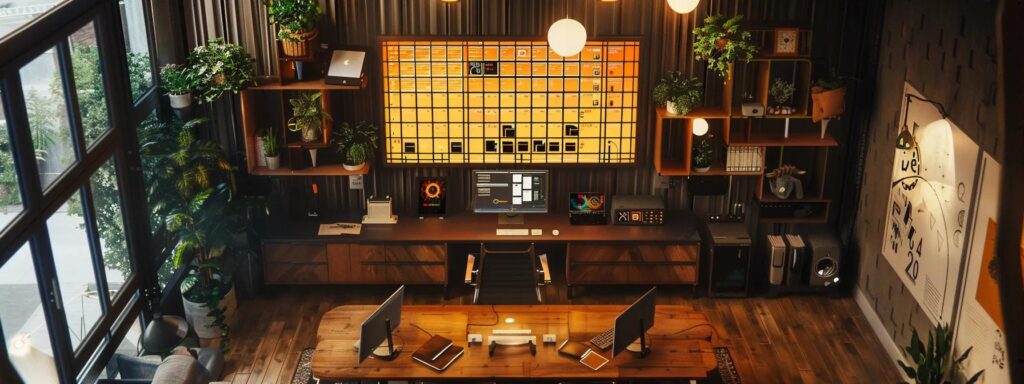Table Of Contents:
Are you a web developer struggling to choose between grid systems and freeform design for your website’s interface? This decision can significantly impact the user experience and the overall effectiveness of your web page. In this article, we will explore the advantages of grid systems, different types available for website layouts, and effective implementation strategies. Readers will gain insights into optimizing their designs, addressing common layout challenges, and staying ahead of emerging trends in grid system design. By understanding these concepts, web developers can create more organized and visually appealing sites.
Understanding Grid Systems in Web Design

A grid system is an essential framework in responsive web design, providing a structured layout for web pages. Key components of grid systems include columns, rows, and media queries, which ensure layouts adjust seamlessly across devices. This section will explore the significance of grids in design, their construction, and their role in enhancing user experience on various screen sizes.
Defining a Grid System
A grid system serves as a foundational element in web design, providing a structured layout that helps designers organize content coherently. By employing columns and rows, a grid system ensures that white space is utilized effectively, enhancing focus on typography and content organization. This approach allows designers to create prototypes that maintain visual consistency across different screen sizes.
In a grid system, CSS plays a critical role in defining the structure and responsiveness of the layout. Designers leverage CSS rules to establish clear guidelines on how elements align and fit within the grid framework. This enables the seamless adjustment of content across devices, making it easier to maintain a polished appearance that meets user expectations.
From a design perspective, the opinion around grid systems is often favorable, especially for those aiming to enhance user experience. By creating organized, visually appealing layouts, a grid system can significantly reduce cognitive load for users, allowing them to navigate content intuitively. Unlike freeform design, which may lead to inconsistencies, grids provide a reliable method for structuring information effectively.
Key Components of Grid Systems
Grid systems are characterized by various key components that enhance effective page layout. Predominantly, columns and gutters create a structure allowing for organized spacing between content elements. This method not only guides visual hierarchy but also accommodates different screen sizes, ensuring scalability for all devices, which is essential in modern website design.
Another vital component is the use of media queries, which enable distinct adjustments of the grid based on the user’s viewing context. By employing these queries, designers can refine interaction design to ensure that a landing page remains functional and visually appealing, regardless of whether it is accessed on a mobile phone or desktop. This adaptability promotes better user experiences across varying devices.
Finally, the alignment of content within the grid is crucial for creating a coherent visual narrative. Effective alignment fosters consistency, allowing users to navigate the website intuitively. As a result, grid systems mitigate confusion and enhance engagement, ultimately supporting businesses in achieving their digital objectives through improved customer interactions.
Grid systems lay the foundation for clear and consistent designs. Now, let’s explore the advantages they offer and why they matter in web development.
The Advantages of Using Grid Systems

The Advantages of Using Grid Systems
Grid systems provide numerous benefits that contribute to effective web design. They create an improved visual hierarchy, facilitating the organization of content through the use of columns and gutters. This structured approach enhances user experience by ensuring consistency across pages. Moreover, grids enable easier responsiveness, allowing elements to stack optimally on various devices while maintaining a coherent layout defined by rectangles as units of measurement.
Improved Visual Hierarchy
Improved visual hierarchy is one of the standout advantages of using grid systems in web design. Web designers can organize content effectively by utilizing a structured approach that ensures elements are strategically arranged according to size and importance. For instance, designers can leverage ratios to define the space allotted to various components, making the layout more intuitive for users navigating a website.
When employing web grid layouts, designers can create cohesive visual flows that enhance usability. This structured format not only helps guide users’ attention to key information but also minimizes the potential for distraction, allowing for smoother interactions. Adobe Photoshop, for example, offers grid options that enable designers to align elements precisely, strengthening the overall organization of the design.
In comparison to freeform design, which may lead to chaotic and disorganized visuals, grid systems promote a clear hierarchy by defining how elements relate to each other. This clarity helps communicate a brand’s message effectively, ensuring that vital information stands out. Proper implementation of grid layouts fosters a sense of familiarity for users, enhancing their overall experience while exploring a website.
Enhanced User Experience
Utilizing grid systems significantly enhances user experience by providing a clear visual hierarchy that guides users through the content. When elements are arranged with precise measurements and established baselines, individuals can navigate websites more intuitively. This structured approach minimizes confusion and allows users to focus on essential information instead of getting lost in a chaotic layout.
By implementing a grid system, designers establish a predictable format that fosters a sense of familiarity for users. Consistent spacing and alignment across different pages contribute to improved usability, as visitors can easily locate desired content. An organized layout helps maintain a seamless flow, allowing users to interact with the site without distractions or interruptions.
Moreover, grid systems adapt seamlessly to varying screen sizes, ensuring that user experience remains optimal across devices. As content scales and repositions based on the grid‘s structure, it provides a cohesive appearance that meets user expectations. This adaptability not only enhances satisfaction but also drives engagement, resulting in better retention and a more successful interaction overall.
Consistency Across Pages
Consistency across pages is a fundamental advantage of utilizing website grid layouts in web design. A grid system establishes a reliable framework that helps maintain uniformity in content presentation, allowing designers to create a cohesive look across various sections of a website. This consistency aids users in developing a sense of familiarity, enhancing their comfort and navigation experience as they interact with the site.
Implementing a grid layout streamlines the workflow for web designers, facilitating the application of material design principles consistently. When each page follows the same gridstructure, it becomes easier to ensure that elements such as headers, footers, and navigation buttons align perfectly, reinforcing the website’s identity. As a result, users experience smooth transitions between sections, mitigating confusion and promoting engagement.
Furthermore, a uniform approach to design contributes to enhanced accessibility for all users. When a website adheres to grid systems, critical information remains easily identifiable across all parts of the site. This attention to consistency not only improves the overall user experience but also complies with best practices in web accessibility, ensuring that all visitors can interact with the content effectively and intuitively.
Easier Responsiveness
Easier responsiveness is a significant advantage of grid systems in graphic design. These systems utilize defined columns and rows that adjust according to the viewport, enabling designers to create layouts that respond effortlessly to various screen sizes. This structured approach allows for improved organization, ensuring that content remains visually appealing regardless of the device used to access it.
For instance, when using grid frameworks, elements can easily shift and resize along with the height of the viewport. This dynamic flexibility not only enhances the user’s experience but also facilitates a consistent presentation of information, which is crucial when engaging audiences across multiple devices. By reducing the complications of manual adjustments often required in freeform design, grid systems streamline the development process.
Moreover, grid systems promote a cohesive layout by ensuring that elements align properly within their designated spaces. The clear structure inherent in this design choice minimizes misalignment issues, making it simple for designers to maintain brand identity and organization. Ultimately, this leads to a more satisfactory interaction for users, as they navigate seamlessly through well-structured content that adapts to their viewing context.
Grid systems provide clarity and order, making design choices easier. Now, let’s look at the different types of grid systems and how they shape website layouts.
Different Types of Grid Systems for Website Layouts

Columngrids, modular grids, and baselinegrids are critical components in web design, each serving distinct purposes. Columngrids offer flexibility and structured layouts, while modular grids break content into uniform sections for clear hierarchy. Baselinegrids align typography consistently to uphold visual harmony. Understanding these grid types enhances knowledge of responsive design, laying the groundwork for effective HTML elements and the golden ratio in various layouts.
Column Grids
Columngrids are a foundational type of grid system widely used in web design, providing a versatile framework for organizing content within a web page. This approach allows designers to allocate space effectively, ensuring that elements such as images, text, and calls to action align properly. For instance, aligning typography within the columns can significantly enhance readability, improving the user experience across different web browsers.
Experts often recommend columngrids for their ability to simplify complex layouts and maintain visual harmony. By employing a consistent structure, designers can create newsletters and other multi-section content that guides users’ attention seamlessly from one section to another. This predictability not only fosters better engagement but also reinforces the brand identity by ensuring that key messages are prominently displayed.
Additionally, columngrids offer essential flexibility, especially when adapting designs for various devices and screen sizes. In their implementation, designers can adjust the number of columns based on the content and available space, ensuring an aesthetically pleasing layout. The strategic use of a silverratio in column widths can further enhance the design, making it more appealing while retaining functionality, ultimately addressing the needs of the target audience.
Modular Grids
Modular grids are crucial in creating structured layouts that enhance user interfaces. By dividing the page into consistent modules, designers can strategically use negative space to guide user attention and improve content readability. This arrangement allows for a balanced presentation of information, making it easier for visitors to navigate the site.
Implementing the rule of thirds within modular grids can take design to the next level. This principle encourages designers to position key elements at intersecting points, creating a more dynamic visual experience. By applying these techniques, designers can produce layouts that not only attract users’ eyes but also convey information efficiently, addressing potential confusion in content-heavy websites.
Additionally, utilizing a modular grid layout is akin to following a manuscript format, where each section has defined boundaries and contributes to overall coherence. This predictability results in a cohesive look and feel, allowing businesses to establish a strong brand identity across various platforms. As a result, modular grids not only streamline the design process but also enhance the user’s experience by creating intuitive navigation paths throughout the site.
Baseline Grids
Baselinegrids are a critical framework in web design, providing a consistent structure for typography across different screen sizes. This concept facilitates harmonious alignment of text elements, helping to maintain visual consistency while catering to various breakpoints. When properly applied, baselinegrids can significantly enhance readability, establishing a clear relationship between headings, paragraphs, and other content.
Incorporating baselinegrids into a design also supports effective brand representation. By standardizing the vertical rhythm of text, designers can create layouts that align with the brand‘s identity. This attentive structure allows users to engage with content in a way that feels familiar and professional, essential for building trust and recognition in a crowded digital marketplace.
While some may favor freeform design for its creative freedom, baselinegrids offer a structured solution that can elevate user experience. For example, designers can ensure that text blocks align neatly, creating a helicopter view of content that directs user focus effectively. This approach minimizes distractions, guiding visitors through the site with ease and clarity. Overall, baselinegrids bridge the gap between organized design and effective communication, reinforcing critical elements of the web page.
Each grid system offers unique strengths that can shape a website’s design. Understanding how to implement these systems effectively will turn a good layout into a great one.
Implementing Grid Systems Effectively

Creating an effective grid system involves several key steps to establish a structured layout that enhances user interface design. This section will discuss tools for designing grid systems, including CSSgrid layout options ideal for mobile apps, as well as common practices that yield optimal results. Implementing these strategies ensures that the grid design website remains responsive and user-friendly across all mobile devices.
Steps to Create a Structured Layout
Establishing a structured layout begins with defining a clear grid framework that serves as the backbone for the design. Designers should outline the number of columns and rows needed based on the content type and user experience design goals. This foundational step ensures that the layout maximizes readability while providing a coherent structure for the elements that will be displayed.
Next, careful attention should be given to spacing and alignment within the grid. Maintaining consistent margins and gutters between columns not only facilitates a clean appearance but also improves the overall user experience. By ensuring elements are crafted within defined spaces, designers can enhance readability and create a more organized interaction for users navigating the site.
Lastly, testing the grid layout across multiple devices and resolutions is paramount. This step allows designers to observe how the structured layout performs in real-world scenarios, ensuring it adapts seamlessly for various screen sizes. Addressing any misalignments or spacing issues during this testing phase will contribute to a polished design that prioritizes both aesthetics and functionality, ultimately enhancing both user experience and engagement.
Tools for Designing Grid Systems
Designing grid systems effectively requires the right tools to create structured and responsive layouts. Popular software such as Adobe XD and Figma offers designers the ability to set grids that align elements intelligently, ensuring a cohesive design from the outset. These platforms include built-in features for customizing column widths and spacing, which simplifies the grid creation process and enhances workflow efficiency.
Another effective tool for grid system design is CSSGrid Layout, a powerful CSS framework that allows developers to implement complex layouts with ease. By defining rows and columns directly in the CSS, designers can create flexible and responsive web pages that adapt seamlessly to varying screen sizes. This not only boosts the site’s usability but also streamlines the coding process, making it easier to manage layouts without extensive manual adjustments.
Additionally, tools like Sketch can be invaluable for creating modular grid designs, particularly when it comes to app and web interface design. With features that allow for precise pixel tracking and alignment, designers can ensure that every component fits perfectly within the gridstructure. This precision reinforces brand identity and promotes user engagement as visitors find it easier to navigate through well-organized layouts.
Common Practices for Optimal Results
To achieve optimal results when implementing grid systems, designers should prioritize maintaining consistent spacing and alignment throughout the design. Consistent margins and gutters between grid elements enhance readability and create a clean, organized layout. This attention to detail directly impacts user navigation, making it easier for visitors to find and engage with content across the website.
Another effective practice involves testing the grid layout across various devices and screen sizes. This step allows designers to evaluate how different layouts perform in real-world scenarios, identifying potential issues with alignment or spacing. By addressing these factors early in the design process, the final product will prioritize both aesthetics and functionality, ensuring users have a seamless experience regardless of the device used.
Lastly, employing the right tools can significantly improve the efficiency of grid design implementation. Software such as Adobe XD and CSSGrid Layout provide frameworks for creating responsive layouts that adapt gracefully to changing viewport sizes. Utilizing these tools enables designers to focus on creating a visually appealing and effective grid system, ultimately guiding users through the content with ease and clarity.
The power of grid systems is best understood through real-world examples. Next, let’s explore case studies that highlight their impact and effectiveness.
Case Studies Showcasing Effective Use of Grid Systems

This section highlights successful websites that effectively utilize grid systems, demonstrating their impact on layout and user interaction. The case studies will reveal valuable lessons learned from grid implementations, showcasing how structured design can enhance functionality and aesthetics. These insights provide practical guidance for leveraging grids in web design, supporting businesses in optimizing their digital presence.
Successful Websites Utilizing Grids
Numerous websites successfully illustrate the effectiveness of grid systems in creating cohesive layouts. For instance, major news platforms like The New York Times leverage grid frameworks to organize diverse content types, ensuring easy navigation while maintaining visual hierarchy. This structured approach enhances user engagement, allowing readers to access information effortlessly across various sections of the site.
Another prime example is Airbnb, which employs a modular grid system to showcase listings and user-generated content. This design choice not only facilitates the presentation of images and details uniformly but also guides visitors through their browsing experience. The clarity achieved through this grid layout significantly contributes to user satisfaction as it enables users to find essential information without confusion.
E-commerce sites like Shopify utilize grid systems to enhance product display and optimization. By organizing products within a well-defined grid, these platforms effectively showcase multiple items while maintaining brand identity. This structured layout improves the user journey, helping potential customers find and compare products easily, ultimately driving conversions and supporting business growth.
Lessons Learned From Grid Implementations
Effective grid implementations showcase the importance of consistency in web design. Successful sites like The New York Times highlight how a well-structured grid fosters user engagement by organizing content clearly. This approach not only enhances visual hierarchy but also directs users’ focus to key information, ultimately improving their browsing experience.
Another insight gained from grid systems is their ability to enhance responsiveness across various devices. For instance, platforms like Airbnb utilize modular grids to adapt layouts seamlessly, ensuring that users have a pleasant experience whether accessing the site on a mobile phone or a desktop. This adaptability illustrates how crucial it is for designers to prioritize user context in layout planning.
Moreover, lessons learned from grid implementations emphasize the value of enhancing readability and usability. In e-commerce sites such as Shopify, structured grids facilitate product comparisons by maintaining uniform presentation. This organized layout not only supports user retention but also drives conversions by making it easier for potential customers to find what they need.
The case studies reveal the strength of grid systems in design. As we look ahead, new trends promise to reshape how these grids will influence our work.
Future Trends in Grid System Design

Innovations in responsivegrids are shaping the future of web design, enhancing layout adaptability across devices. The integration of AI tools is streamlining grid design processes, offering designers new ways to create responsive frameworks. Predictions suggest that web layouts will increasingly prioritize user experience, with a focus on consistency, functionality, and aesthetic appeal, reshaping the landscape of grid systems.
Innovations in Responsive Grids
Innovations in responsivegrids focus on enhancing flexibility and usability across devices. New CSS technologies, such as CSSGrid Layout, empower designers to create adaptable frameworks that adjust effortlessly to various screen sizes. This approach enables a more intuitive user experience as content seamlessly reorganizes based on the user’s device, addressing common issues related to inconsistent layouts in freeform design.
Emerging design tools also contribute significantly to the development of responsivegrids. Platforms like Figma and Adobe XD now incorporate features that simplify the grid creation process, allowing for instant adjustments and real-time previews. These advancements make it easier for designers to implement responsive solutions, ensuring that user engagement remains high by offering a cohesive experience on any device.
Furthermore, the integration of AI in web design is beginning to influence responsivegrid innovations. By analyzing user behavior patterns, AI can suggest modifications to grid structures that enhance user navigation. This capability helps designers refine layouts purposefully, ultimately leading to improved accessibility and interaction, which are critical considerations in choosing between grid systems and freeform design.
The Impact of AI on Grid Design
The integration of artificial intelligence (AI) in grid design is transforming the approach to web layout and user experience. AI tools can analyze user behavior and interactions, allowing designers to create grid frameworks that are not only visually appealing but also highly responsive to user needs. This data-driven approach enhances the overall effectiveness of grid systems by ensuring they adapt to various usage patterns and screen sizes seamlessly.
AI’s capabilities extend to automating layout adjustments based on real-time user feedback, which significantly improves the design process. For example, AI can suggest optimal grid structures that prioritize essential content, making it easier for users to find what they are looking for quickly. This capability alleviates the challenges often faced in freeform design, where layouts can become chaotic and less intuitive.
Moreover, as AI technology evolves, it will likely contribute to the development of more sophisticated grid systems that incorporate personalization features. These advancements will enable designers to craft tailored user experiences, enhancing engagement and satisfaction. By prioritizing user preferences and behavioral insights, AI enhances the relevance of grid design, bridging the gap between structured layouts and the need for individualized content delivery.
Predictions for Web Layouts in the Coming Years
As technology evolves, the future of web layouts is expected to focus more on user experience and adaptability. Designers are likely to prioritize grid systems that allow for seamless integration across devices, ensuring that content remains accessible and visually appealing whether viewed on a smartphone or desktop. The emphasis on responsive design will drive the adoption of frameworks that support dynamic adjustments, enhancing the overall interaction users have with digital platforms.
Moreover, the emergence of artificial intelligence in web design will influence how layouts are structured. AI can analyze user behavior and recommend optimal grid arrangements that improve navigation and engagement. By taking data into account, designers can create layouts that not only provide aesthetic appeal but also cater to specific user needs, bridging the gap between structured design and personalized content delivery.
Lastly, collaboration between design teams and developers is anticipated to increase, facilitating the implementation of innovative grid systems. This partnership will enable the creation of layouts that are not only functional but also align with branding goals and user expectations. As a result, businesses can expect structured frameworks to play a pivotal role in enhancing their online presence while ensuring that visitors have a satisfying and intuitive experience on their websites.
Conclusion
In web design, grid systems provide a structured framework that enhances user experience through improved visual hierarchy, consistency, and responsiveness. Unlike freeform design, which can lead to chaotic layouts, grid systems simplify content organization, making it easier for users to navigate and engage with information. By employing grids, designers achieve cohesive aesthetics that adapt across various devices, ensuring accessibility and satisfaction for all users. Ultimately, choosing grid systems over freeform design fosters clarity and effectiveness, significantly contributing to the success of digital platforms.


